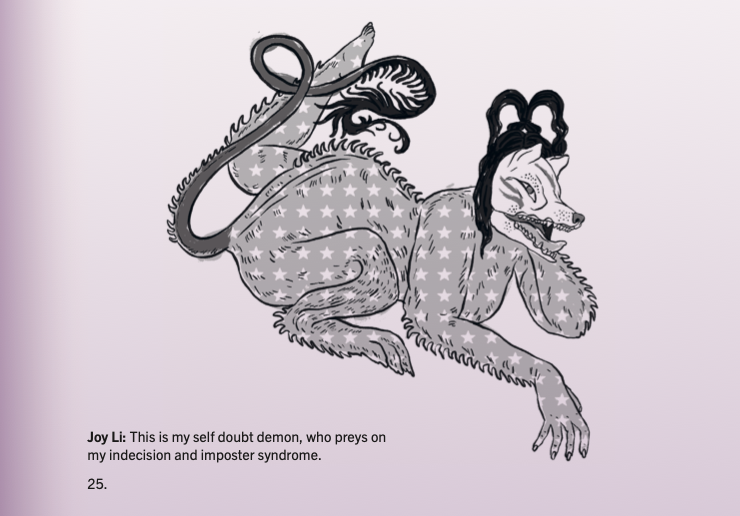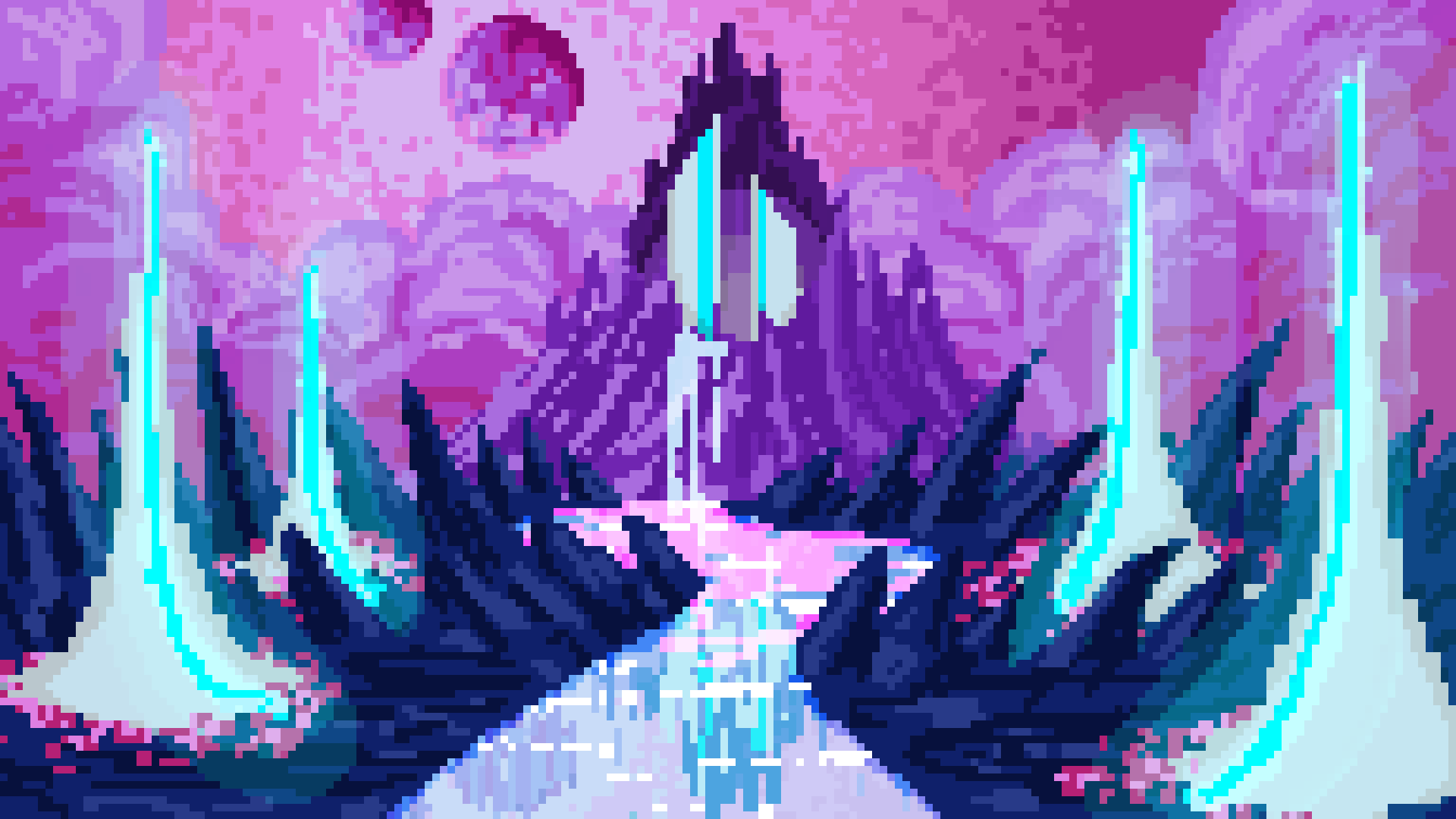Read about Dr Mykaela Saunders’s approach to writing cultural stories
Dr Mykaela Saunders is a Koori/Goori and Lebanese writer, researcher, educator and a leading voice in Indigenous storytelling. In our SCI-FI zine, she shared her fearless and committed approach to storytelling and some of the complex questions that First Nations writers face in their work. Read Dr Saunders’s essay Forbidden Door.
Illustration by Joy Li for SCI-FI zine
Forbiden Door. GenreCon 2023.
I was asked to speak at the opening of GenreCon 2023 at the State Library of Queensland, on the Maiwar in Magandgin. The theme that year was Forbidden Doors and when I was asked to speak on this theme, my mind kept coming back with the question – are there any forbidden doors for a writer? And I guess the answer has to be either yes or no, and this answer will be different for everybody, and for those who say ‘yes there are forbidden doors’, exactly what those doors are and why they’re forbidden will vary wildly from person to person. But none of that matters too much because for the next few pages or so you’re all here to read what I have to say, so whether I have any forbidden doors or not is the most pressing concern for now.
“I like to think I don’t have any forbidden doors that I won’t open – that I’m so bold and daring, and that nobody can tell me what I can and can’t do. But that’s not true.”
I like to think I don’t have any forbidden doors that I won’t open – that I’m so bold and daring, and that nobody can tell me what I can and can’t do. But that’s not true. I’m the one who tells myself what I can and can’t do – or, more accurately, what I should and shouldn’t do. And, as a Goori writer, a connected, relational community-based person, my cultural obligations absolutely inform what I write, and why, and who I write it for. I know that not every writer has these considerations, though I wish more people would – but let’s keep in mind that this short section of this zine is all about me, so that’s what we need to think about.
So anyway, when I write, I have all these voices in my head telling me what’s good, what’s not, what’s right and wrong – and mind you, these voices all have very strong Tweed blackfella accents – and even though it gets a bit crowded upstairs sometimes, this is just the way my culture works, and how it works through me, and indeed it is why we have thrived for the past countless millennia, including surviving one drawn-out, world-shattering apocalypse over the last few hundred years. This is the way my people stay accountable to each other, and not just in the here and now, but across time too – how we stay responsible to our countless ancestors, and how we act in good faith toward our countless descendants too. As one example, culturally, there are many things I can’t ever know or and things I can’t say to others, and that’s okay. I won’t ignore these morals just because I want to write cultural stories. Instead I’ll figure out the best ways to tell my stories, with respect – figuring out what to leave out or how to distort it so much that the meaning can’t be read head on.
And so finally, we arrive at my point, in talking about forbidden doors in the context of genre and storytelling. Because as a Goori writer, and one who only started on this path a few years ago, I have had a hell of a lot to think about in terms of what kind of a writer I want to be. Like many writers, I’m sure, I don’t want to write easily digestible fodder for a mass audience. I want to write stories that make my weird little brain happy with its particular tastes and styles that gets its juices flowing. Unfortunately, this isn’t always the most lucrative choice to make as a writer, but I do it because I want to write my weird little stories that centre and celebrate my community and culture, and by necessity that means risking alienating 98% of the market (non-Indigenous readers). I know there are some Aboriginal writers who do in fact write for a white audience, and good for them I suppose, but my cultural consciousness – you know, those voices in my head – forbids me from not serving my people in all that I do. Hell, the whole reason I started writing speculative fiction in the first place was because so many futuristic Australian stories had either annihilated or assimilated Indigenous people in their various worlds. Think of Mad Max, the most famous of these stories, where the only Aboriginal character across the whole four movie franchise is a dead ghost who haunts Max in Fury Road, and tells him that you let us die. How apt is that as a metaphor for how Indigenous people appear in Australia’s imagination of the future? And little wonder, given the history here.
“So, I wanted to write back against this absence, and write my people into the future – and whether we want to believe it or not, that has been a hugely forbidden door for the majority of Australian writers throughout this colony’s short history. ”
So, I wanted to write back against this absence, and write my people into the future – and whether we want to believe it or not, that has been a hugely forbidden door for the majority of Australian writers throughout this colony’s short history. The white supremacist consciousness absolutely forbids anyone from thinking about Indigenous people existing in the future, let alone thriving.
Illustration by Joy Li for SCI-FI zine
It has been a forbidden door for Indigenous writers too, because there have been many real attempts at genocide on our people over the last few centuries, and so even imagining our people existing in the future is a great act of refusal of the racist status quo. We have never been a dying race like many Australian stories would have you believe, but we have been a persecuted race.
And through the tools of speculative fiction, and with that chorus of strong community voices in my head as I write, I can break through any of those forbidden doors that Australia has built to keep us down, to keep us preserved as ancient relics of a dying past, and I can step through that threshold that should never have been built in the first place, and more than that, I can hold that door open behind me so other Aboriginal and Torres Strait Islander writers can come through the door too – because the truth is, I’m not the first or the best to do this. The only reason I have been able to step through that forbidden door so easily is because other Indigenous spec fic writers did it before me – people like Uncle Sam Watson, Archie Weller, Alexis Wright, and many others, who held the door open behind them too.
Would you like to hear more about First Nations speculative fiction? Watch Dr Saunders’s lecture Laying Down the Lore delving into the key subgenres and peruse her recommended reading list.
Dr Saunders is part of the SCI-FI: Mythologies Transformed Expert Advisory Group and compiled a selection of speculative fiction books by First Nations authors for the Science Fiction Timeline.
This essay first appeared in the SCI-FI: Mythologies Transformed exhibition zine.






